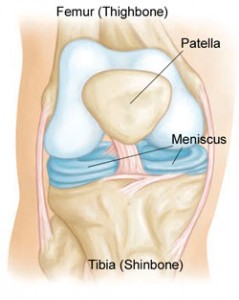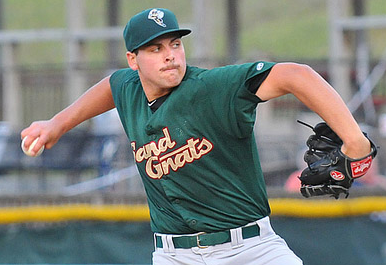It hasn’t been officially announced yet, but Michael Fulmer will probably be spending some time on the disabled list to start this season after successfully undergoing knee surgery to repair a torn meniscus in his right knee in early March.
I checked in with Joe D. and he has received reports that Fulmer is rehabbing his knee with no problems, everything is going smoothly, and he should be back on a mound some time in early May. The recovery time for the torn meniscus is anywhere from three to ten weeks, depending on the severity of the tear.
I called on MMO’s injury and recovery expert, Ken Stabler, of Ropestone Fitness, to give a more detailed look at how the meniscus tears affect pitchers, and what type of recovery Fulmer may be going through to get back on the field.
Thoughts from Ken
The meniscus is a cartilaginous tissue that cushions the knee and acts as a shock absorption mechanism. Basically, your knee is a junction site. The femur (thigh bone) and tibia (shin bone) meet at the knee. The patella bone (knee cap) protects the junction site. Tendons (ACL, MCL, LCL) hold this site together so it stays strong and mobile. The meniscus is the padding that provides an outlet for stress so the knee isn’t compromised by bone on bone contact.
 Pitching puts the meniscus in a compromising position. When a pitcher starts his motion he will place weight on his “driving leg” and then swing his opposite leg in front to get into a position to create a powerful throw. When the front leg (swinging leg) begins to go forward the hips twist which is where the power comes from. By the time the ball is let go, the driving leg comes off the ground to follow the hips around and complete the motion but before it does, there is a medial (inward) twist and downward force at the knee. These two actions don’t mesh well together.
Pitching puts the meniscus in a compromising position. When a pitcher starts his motion he will place weight on his “driving leg” and then swing his opposite leg in front to get into a position to create a powerful throw. When the front leg (swinging leg) begins to go forward the hips twist which is where the power comes from. By the time the ball is let go, the driving leg comes off the ground to follow the hips around and complete the motion but before it does, there is a medial (inward) twist and downward force at the knee. These two actions don’t mesh well together.
The good news is that the torque created by these two forces isn’t that substantial so there usually isn’t damage done. The bad news is that pitchers repeat this motion thousands of times and all it takes is one rep in the wrong form or their cleat to get stuck in the dirt for a second to create that extra torque and cause an injury. Some pitchers might not have strong enough cartilage to sustain this repetitive motion. It could be bad genetics, maybe they are nutrient deficient? There could be numerous causes for a meniscus injury but the one constant is the actual pitching motion.
So what do we do? Change the way the game is played and the pitching motion? Not a chance! That’s just crazy talk. We need to program for this motion. It is called the “Rule Of Specificity.” The baseball expert as far as strength and conditioning goes is Eric Cressey. For any detailed or in-depth knowledge about programs for baseball players, I would highly recommend visiting his website: cresseyperformance.com. I won’t go into rehab, because it is pretty basic and has become a well oiled machine. What I will outline for you is the way I would attack injury prevention for the meniscus.
- Sleep: Sleep is your time to regenerate. Your body is able to repair itself. EVERYONE and especially athletes need to get 8 hours of quality sleep. Turn off the television, no caffeine after 1pm, and eat a balanced diet. Most people are deficient in magnesium, which plays a role in sleep regulation. A great source of magnesium which can serve as a pre-bed tea is a supplement called Natural Calm. Melatonin can also be helpful in regulating your sleep cycles.
- Nutrition: We are what we eat. I say it all the time. The strength of your bones, ligaments, tendons, cartilage depends on what you put in your body. Sure, genetics play a role too, but there isn’t some magic mechanism in your body that makes stuff. Your body is dependent on what you put in it. The TFW theory is basic. We eat the “warrior 20” which consist of a variety of lean meats/fish, dark or brightly colored fruits & veggies, sweet potato, quinoa, oatmeal for carbs, nuts & oils. That is it in a nut shell. Supplement when needed. One supplement I recommend for athletes to be on is a joint supplement. Like we discussed earlier, constant torque on the joint will break it down over time so a joint supplement can decrease the risk of injury.
- Strength & Conditioning: A pitcher’s warm-up should resemble something like this: neuro activation, proprioception activities, dynamic flexibility, hip and scapular activation, prep phase for the workout. Before the warm-up, he should have gone through a thorough pre-hab session complete with foam rolling, joint rotations, and addressing any “hot spots” he has. Just these two aspects will decrease the likelihood of injury and we didn’t even discuss his program. I would need a whole other series of articles to get into that, but the program will vary depending on his assessment and imbalances. I am not a huge functional guy, but you can’t ignore the efficacy of some of the exercises like single leg squats and dead lifts. What those will do is increase the proprioception of the knee, forcing it to stabilize to a greater extent. That is important for a pitcher because of the unstable surface they work on and because those exercises will strengthen the joint more to be able to handle the thousands of reps they perform.
Pitchers shouldn’t be on the same program as catchers, catchers shouldn’t be on the same program as outfielders, and etc. Baseball is a deceivingly complex sport when it comes to physiology. Everyone on the field has a different reaction to the game. This makes it hard for the strength and conditioning coach to plan for everyone.
Hopefully Michael Fulmer gets back on the field in early May, as planned, and adds yet another solid arm to the already scary St. Lucie Mets rotation.

